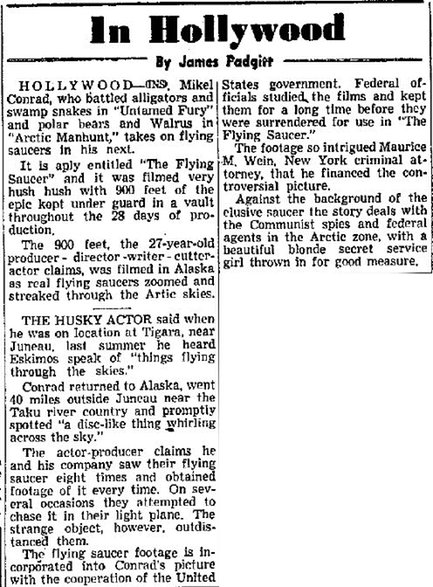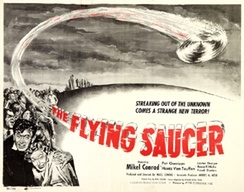50s Hollywood UFO Fraud
Resurfaces In UFO News
4-5-2010

One of the first, if not THE first "flying Saucer"
flicks produced in the 1950s was Mikel Conrad's ever-so-cheesy "The
Flying Saucer." In the newspaper clipping below, now making its
rounds on the net again without proper vetting of the whole story, Conrad
claimed he used REAL UFO footage shot in Alaska while making his epically
bad B-movie, still ranked as one of the all-time worst. The YouTube
clip above makes this more than evident.

Excerpt: With the prospect of both Reds and Martians under the
bed, it should come as little surprise to learn that when America’s
very first UFO movie, The Flying Saucer (1950), went into production
in 1949 it registered quickly on the USAF radar.
The film’s director, Mikel Conrad, had claimed publicly whilst
still in production that he had managed to secure genuine footage of
a real flying saucer for use in his movie. In September 1949, Conrad
told the Ohio Journal Herald, “I have scenes of the saucer landing,
taking off, flying and doing tricks.” Conrad further claimed that
his remarkable footage was “locked in a bank vault” and
would not be shown to anybody prior to his movie’s release; shortly
thereafter Conrad became the subject of a two month official Air Force
investigation. Documents released under the Freedom of Information Act
reveal that an agent of the Air Force Office of Special Investigations
was dispatched not only to grill Conrad about his claims, but also to
attend the first private screening of his completed movie.

Unsurprisingly, Conrad’s fantastical
claims proved to be without substance – when challenged by the
USAF, he admitted that his saucer story was nothing more than an elaborate
marketing scam designed to generate media buzz around what was, in reality,
a tedious and uneventful movie.vi Nevertheless, what the Conrad case
demonstrates, according to researcher Nick Redfern, “is that the
Air Force at the time was taking a keen interest in fictional films
about UFOs.” Redfern, who has studied the original documentation
on the Conrad Case, suggests that the USAF may have considered it “problematic
that someone was making a film about UFOs that could have contained
real footage.”vii Redfern speculates that, from this point on,
the USAF learned to be on the lookout for any other pesky UFO movies
lurking on the horizon, and to carefully monitor – and even control
– their content on grounds of national security.
The above scenario seems plausible in light of the production of a major
UFOlogical documentary in 1956, entitled U.F.O., which compelled the
USAF to draw up contingency plans to counteract the anticipated fallout
from the film upon its release. The director of the USAF’s official
UFO investigations unit, Project Blue Book, Captain George T. Gregory,
was tasked with monitoring not only the film’s production process,
but its public and critical reception. Believing that the film would
stir up a “storm of public controversy,” the USAF had set
about preparing a special case file that would debunk every saucer sighting
examined in the movie and even went so far as to have three of its Blue
Book officers provide “technical assistance” to the filmmakers
in an effort to control the content of the documentary.viii/(1)
vii - Redfern, Nick, telephone interview with Robbie
Graham, Oct. 30, 2008.
(1) http://www.presidentialufo.com/disney-ufo-connection/267-
close-encounters-with-the-pentagon
Credit: Sightings.com